
French postcard by ISV / Huit, no. B 9. Photo: 20th Century Fox. Publicity still for Sea Wife (Bob McNaught, 1957).
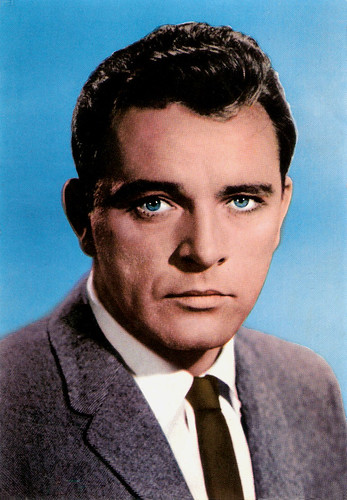
Spanish postcard by Postalcolor, Barcelona, no. 35, 1963.
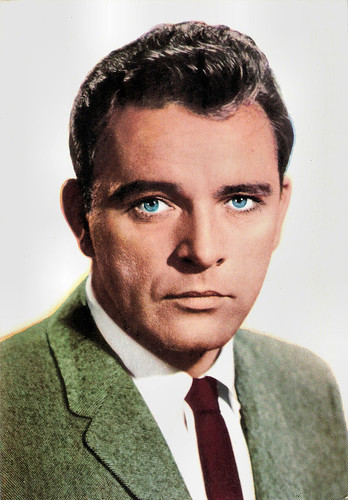
Spanish postcard by Postal Oscarcolor, no. 118.
An impoverished Welsh living
Richard Burton was born Richard Walter Jenkins in the village of Pontrhydyfen, Wales in 1925. He was the twelfth of thirteen children. His father, Richard Walter Jenkins, was a short, robust coal miner, a ‘twelve-pints-a-day man’. Burton was less than two years old in 1927 when his mother, Edith Maude (née Thomas), died at the age of 43 after giving birth to her 13th child. His sister Cecilia ‘Cis’ and her husband Elfed took him into their Presbyterian mining family in nearby Port Talbot (an English-speaking steel town). He grew up speaking Cymraeg (Welsh) as well as English. His 19 year older brother Ifor became his de facto father figure, and in later years, his assistant and boon companion.
Burton showed a talent for English and Welsh literature at grammar school, and demonstrated an excellent memory, though his consuming interest was sports – rugby. He earned pocket money by running messages, hauling horse manure, and delivering newspapers. He started to smoke at the age of eight and to drink regularly at twelve. He believed that the way out of an impoverished Welsh living was to read, and he was always reading books.
Inspired by his schoolmaster, Philip H. Burton, he excelled in school productions, his first being The Apple Cart. The young man had spoken no English until the age of ten. Burton taught him to speak English without a Welsh accent, to read the classics, and to hold a knife and fork. Richard left school at sixteen for full-time work. He worked for the local wartime cooperative committee, handing out supplies in exchange for coupons, but then considered other professions for his future, including boxing, religion and singing.
When Jenkins joined the Port Talbot Squadron of the Air Training Corps as a cadet, he re-encountered Philip Burton, his former teacher, who was the commander. Burton rigorously schooled him in both literature and acting, even sending him to Welsh mountaintops to work on voice projection. After receiving his school certificate, Richard was accepted to Exeter College at Oxford for a special term of study. In order to gain admittance as an undergraduate, Philip Burton was required to adopt the young man; after discovering that it was legally impossible to do so, he made Richard his ward and changed his surname to Burton.
Before leaving for Exeter, Burton made his professional acting debut in the play The Druid's Rest in 1944. The show was successful enough to move to London, where he received his first positive review in the New Statesman magazine. Those words would solidify Burton's resolve to become an actor. While at Exeter, he appeared in his first significant Shakespearean role - Angelo in Measure for Measure - before an audience that included such important theatrical figures as John Gielgud and Terence Rattigan. Subsequently, he served in the RAF (1944–1947) as a navigator. In 1947, after his discharge, Burton went to London to seek his fortune. He immediately signed up with a theatrical agency to make himself available for casting calls. His first film was The Last Days of Dolwyn (Russell Lloyd, Emlyn Williams, 1949), set in a Welsh village about to be drowned to provide a reservoir.
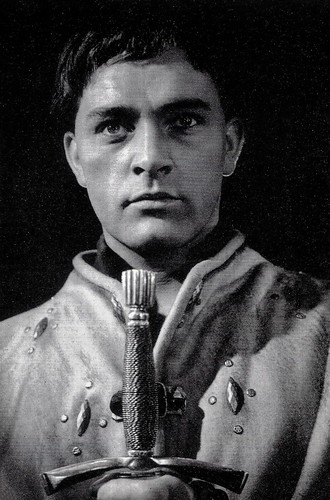
British postcard in the Shakespeare Memorial Theatre series, no. 18. Photo: Angus McBean. Richard Burton as Prince Hal in the stage production of Henry IV, Part I and Henry IV, Part 2, Stratford-upon-Avon, 1951.
He met his future wife, the young actress Sybil Williams, on the set, and they married in 1949. They had two daughters and divorced in 1963 after Burton's widely reported affair with Elizabeth Taylor. In the years of his marriage to Sybil, Burton appeared in the West End in a highly successful production of The Lady's Not for Burning, alongside Sir John Gielgud and Claire Bloom, in both the London and New York productions.
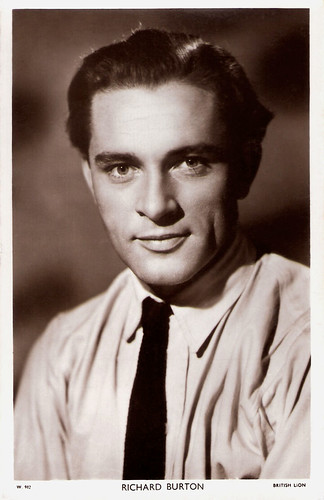
British postcard in the Picturegoer series, London, no. W 912. Photo: British Lion.

Danish postcard by Kaj Brammers Boghandel, Helsingor, no. 748. Photo: publicity still for the stage production of 'Hamlet' at the Hamletspillene in Kronborg, 1954. Richard Burton as Hamlet and Claire Bloom as Ophelia.
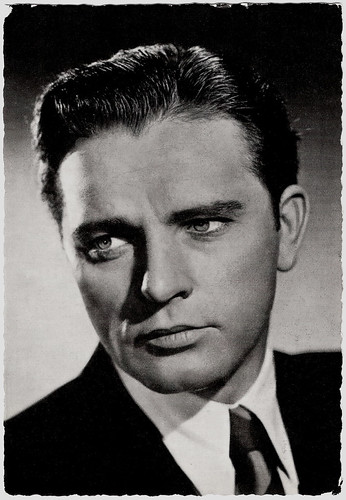
German postcard by WS-Druck, Wanne-Eickel, no 226. Offered by Macaroni Honig, Gent (Belgium). Photo: Centfox.
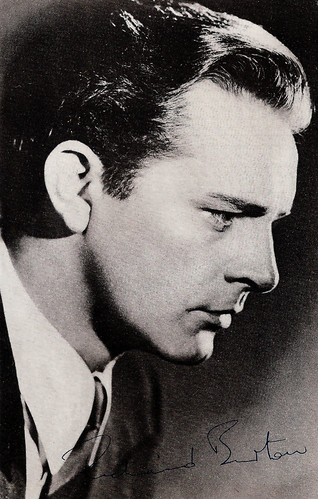
British postcard in the Film Star Autograph Portrait series by Celebrity Publishers, London, no. 79.
A watchful brooding intensity
Richard Burton had small parts in various low-key British films: Now Barabbas (Gordon Parry, 1950) starring Richard Greene, Waterfront (Michael Anderson, 1950) with Robert Newton, The Woman with No Name (Ladislao Vajda, 1951) featuring Phyllis Calvert, and a bigger part as a smuggler in the B-film Green Grow the Rushes (Derek N. Twist, 1951). He displayed a watchful brooding intensity in these films.
In the 1951 season at Stratford, he gave a critically acclaimed performance and achieved stardom as Prince Hal in Shakespeare's Henry IV, Part 1 opposite Anthony Quayle's Falstaff. Burton was already demonstrating the same independence and competitiveness as an actor that he displayed off-stage in drinking, sport, or story-telling. He was admitted to the post-War British acting circle which included Anthony Quayle, John Gielgud, Michael Redgrave, Hugh Griffith and Paul Scofield.
The following year, Burton signed a five-year contract with Alexander Korda at £100 a week, launching his Hollywood career. On the recommendation of Daphne du Maurier, he was given the leading role in the mystery romance My Cousin Rachel (Henry Koster, 1952) opposite Olivia de Havilland. Burton arrived on the Hollywood scene at a time when the studios were struggling. Television's rise was drawing away viewers and the studios looked to new stars and new film technology to staunch the bleeding. 20th Century Fox negotiated with Korda to borrow him for this film and a further two at $50,000 a film. My Cousin Rachel was a critical success. It established Burton as a Hollywood leading man and won him his first Academy Award nomination and the Golden Globe Award for New Star of the Year – Actor.
In the wartime action-drama The Desert Rats (Robert Wise, 1953), Burton plays a young English captain in the North African campaign during World War II who takes charge of a hopelessly out-numbered Australian unit against the indomitable Field Marshal Erwin Rommel (James Mason). Then he created a sensation by starring in the biblical epic The Robe (Henry Koster, 1953), the first film to premiere in the wide-screen process CinemaScope. The film was a colossal hit, it gave Burton his second Oscar nomination and minted him as a genuine movie star. Burton was offered a seven-year, $1 million contract by Darryl F. Zanuck at Fox, but he turned it down, though later the contract was revived and he agreed to it. Between 1953 and 1956, he was juggling theatre with film, playing Hamlet and Coriolanus at the Old Vic theatre and alternating the roles of Iago and Othello with the Old Vic's other rising matinee idol John Neville. For his Henry V, he won the Evening Standard drama award.
Known for his resonant voice he also gave frequent readings of classic works on BBC Radio. In 1954, Burton took his most famous radio role, as the narrator in the original production of Dylan Thomas' 'Under Milk Wood', a role he would reprise in the film version twenty years later. Burton appeared on Broadway, receiving a Tony Award nomination for 'Time Remembered' (1958) and winning the award for playing King Arthur in the musical 'Camelot' (1960). The latter show went on to run for over 800 performances and netted a total of four Tony Awards. He then put his stage career on the back burner to concentrate on film.
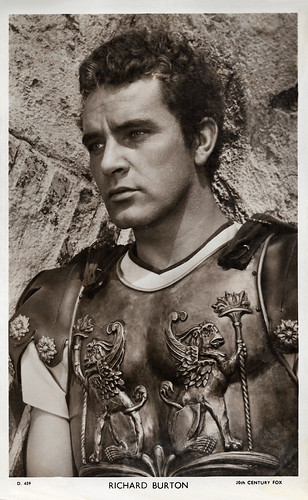
British postcard in the Picturegoer Series, London, no. D 459. Photo: 20th Century Fox. Richard Burton in The Robe (Henry Koster, 1953).
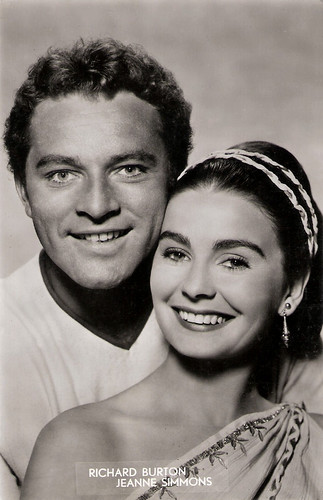
French postcard. Photo: publicity still for The Robe (1953) with Jean Simmons.
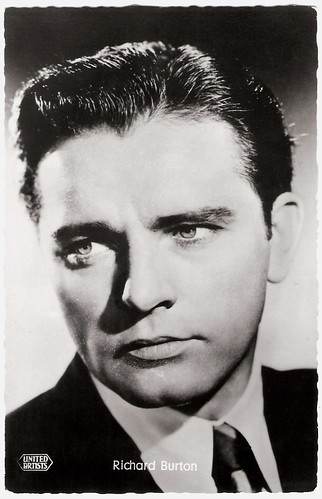
German postcard by Kolibri-Verlag G.m.b.H., Minden/Westf., no. 2395. Photo: United Artists. Publicity still for Alexander the Great (1956).
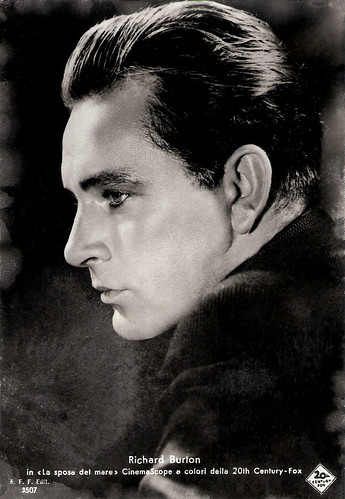
Italian postcard by B.F.F. Edit. (Ballerini & Fratini, Firenze), no. 2507. Photo: 20th Century Fox. Publicity still for Sea Wife (Bob McNaught, 1957).

West-German postcard by Ufa, Berlin-Tempelhof, no. FK 4738. Photo: Terb-Agency.
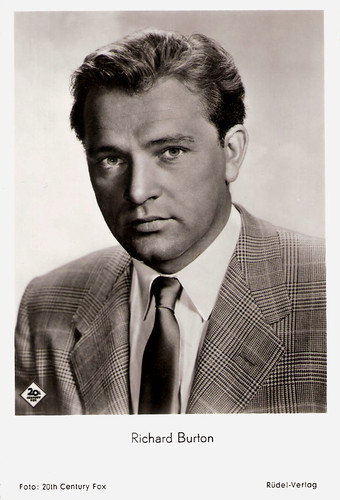
West-German postcard by Rüdel Verlag, Hamburg-Bergedorf, no 1453. Photo: 20th Century Fox.
Liz and Dick
In terms of critical success, Richard Burton's Hollywood roles throughout the 1950s did not live up to the early promise of his debut. Burton returned to Hollywood to star in The Prince of Players (Philp Dunne, 1955), another historical CinemaScope film, this time concerning Edwin Booth, famous American actor and brother of Abraham Lincoln's assassin John Wilkes Booth. Next came Alexander The Great (Robert Rossen, 1956), with the handsome and self-assured Burton in the title role, on a loan out to United Artists, and again with Claire Bloom co-starring. Contrary to Burton's expectations, the ‘intelligent epic’ was a wooden, slow-paced flop. In The Rains of Ranchipur (Jean Negulesco, 1955) Burton plays a noble Hindu doctor who attempts the spiritual recovery of an adulteress (Lana Turner). In Sea Wife (Bob McNaught, 1957), shot in Jamaica, a young Joan Collins plays a nun shipwrecked on an island with three men.
For British cinema, the late 1950s was an exciting and inventive time, often referred to as the British New Wave, and Burton was right in the thick of things. In 1958, he was offered the part of Jimmy Porter, ‘an angry young man role, in the film version of John Osborne's play Look Back in Anger (Tony Richardson, 1959). Hal Erickson writes at AllMovie: “His own film greatness would not manifest itself until he played the dirt-under-the-nails role of Jimmy Porter in Look Back in Anger (1959). In this, he spoke the vernacular of regular human beings - rather than that of high-priced, affected Hollywood screenwriters - and delivered a jolting performance as a working-class man trapped by the system and his own personal demons.” Although it didn't do well commercially, Burton was proud of the effort. After playing King Arthur in 'Camelot' on Broadway for six months, Burton was one of the ‘42 international stars’ that appeared in the massive World War II epic The Longest Day (Ken Annakin, Andrew Marton, Bernhard Wicki, 1962).
And then he replaced Stephen Boyd as Mark Antony in the troubled production Cleopatra (Joseph L. Mankiewicz, 1963). Twentieth Century Fox's future appeared to hinge on what became the most expensive movie ever made up until then. During the filming, Burton met and fell in love with Elizabeth Taylor, who was married to Eddie Fisher. Such was the scandal surrounding the Burton-Taylor romance that the U.S. State Department was requested to revoke Burton's visa on grounds that he was ‘detrimental to the morals of the youth of our nation.’ The tidal wave of press about the very public affair only helped to bring the curious public to theatres, which made it the highest-grossing film of the year - though still a financial disaster, since its $26 million in ticket sales could never cover its price tag (an estimated $40 million). Cleopatra proved to be the start of Burton's most successful period in Hollywood; he would remain among the top 10 box-office earners for the next four years.
He and Taylor would not be free to marry until 1964 when their respective divorces were complete. Their marriage was the start of a series of on-screen collaborations. In the first, The V.I.P.s (Anthony Asquith, 1964), Burton played a husband who tries to prevent his wife (Taylor) from leaving to join her lover (Louis Jourdan) in the VIP lounge of London Airport. It proved to be a box-office hit. Liz and Dick, as they were known, lived on a grand scale. He bought her jewels, including a 69-carat Cartier diamond. They bought a yacht for $500,000. Then he portrayed the archbishop martyred by Henry II in the title role of Becket (Peter Glenville, 1964), turning in an effective, restrained performance, contrasting with Peter O'Toole's manic portrayal of Henry.
Burton triumphed as defrocked Episcopal priest Dr. T. Lawrence Shannon in Tennessee Williams' The Night of the Iguana (John Huston, 1964), a film which became another critical and box office success. Part of Burton's success in this film was due to how well he varied his acting with the three female characters, each of whom he tries to seduce differently: Ava Gardner (the randy hotel owner), Sue Lyon (the nubile American tourist), and Deborah Kerr (the poor, repressed artist). He received a third Tony Award nomination when he reprised his 'Hamlet' under John Gielgud's direction in 1964 in a production that holds the record for the longest run of the play in Broadway history (136 performances).
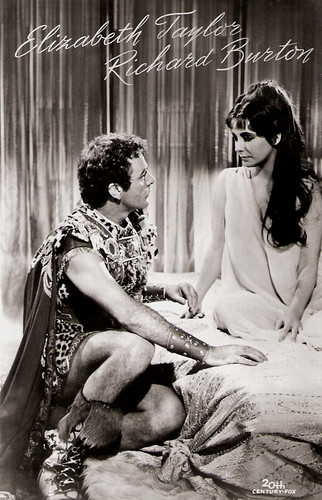
German postcard by Filmbilder-Vertrieb Ernst Freihoff, Essen, no. AX 5536. Photo: publicity still for Cleopatra (Joseph L. Mankiewicz, 1963) with Elizabeth Taylor.
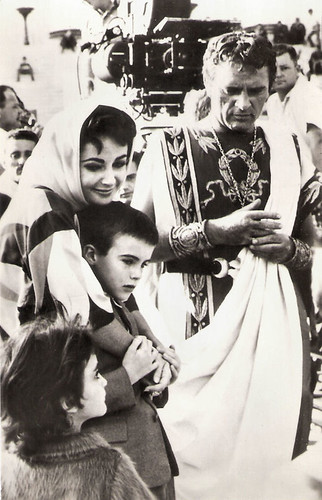
Czech collectors card by Pressfoto, Praha (Prague), no. S 229/2 769. Set photo of Cleopatra (Joseph L. Mankiewicz, 1963) with Elizabeth Taylor and her children.
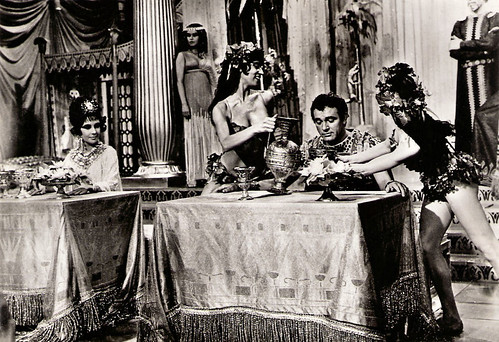
Czech postcard by UPTF Pressfoto, Praha (Prague), no. S 206/7. Photo: publicity still for Cleopatra (Joseph L. Mankiewicz, 1963) with Elizabeth Taylor.
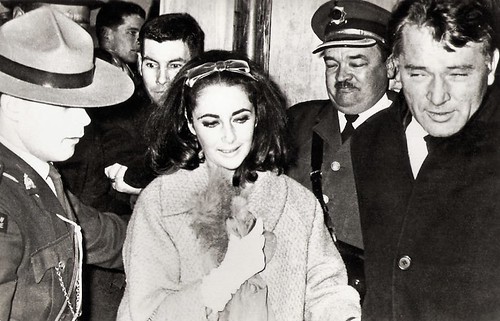
Czech collectors card by Pressfoto, Praha (Prague), no. S 229/6 769, with Elizabeth Taylor.

Romanian postcard by Casa Filmului Acin, no. 94. Elizabeth Taylor and Richard Burton in The Comedians (Peter Glenville, 1967). Collection: Alina Deaconu.
Lush and rollicking
Richard Burton returned to the cinema as British spy Alec Leamas in The Spy Who Came in from the Cold (Martin Ritt, 1965). Burton and Taylor continued making films together though the next one, The Sandpiper (Vincente Minnelli, 1965), was poorly received. Following that, he and Elizabeth Taylor were a great success in the film adaptation of the Edward Albee play Who's Afraid of Virginia Woolf? (Mike Nichols, 1966), in which a bitter erudite couple spend the evening trading vicious barbs in front of their horrified and fascinated guests, played by George Segal and Sandy Dennis. Burton was not the first choice for the role of Taylor's husband. Jack Lemmon was offered the role first, but when he backed off, Jack Warner, with Taylor's insistence, agreed on Burton and paid him his price. Although all four actors received Oscar nominations for their roles in the film (the film received a total of thirteen), only Taylor and Dennis went on to win.
Their lush and rollicking adaptation of Shakespeare's The Taming of the Shrew (Franco Zeffirelli, 1967), was a notable success. Later collaborations, however, The Comedians (Peter Glenville, 1967), Boom! (Joseph Losey, 1968), and the Burton-directed Doctor Faustus (Richard Burton, Nevill Coghill, 1967) (which had its genesis from a theatre production he staged and starred in at the Oxford University Dramatic Society) were critical and commercial failures.
He did enjoy a final commercial blockbuster with Clint Eastwood in Where Eagles Dare (Brian G. Hutton, 1968) but his last film of the decade, Anne of the Thousand Days (Charles Jarrott, 1969), was a commercial and critical disappointment. In spite of those failures, it performed remarkably well at that year's Academy Awards (receiving ten nominations, including one for Burton's performance as Henry VIII), which many thought to be largely the result of an expensive advertising campaign by Universal Studios.
He was awarded the CBE (Commander of the Order of the British Empire) in the 1970 Queen's Birthday Honours List for his services to drama. He collected this award on his 45th birthday with his older sister Cis, who raised him as a child, and his wife Elizabeth Taylor. Due to Burton and Taylor's extravagant spending and his support of his family and others (42 people at one point), Burton agreed to work in mediocre films such as Bluebeard (Edward Dmytryk, Luciano Sacripanti, 1972) opposite Virna Lisi, Hammersmith Is Out (Peter Ustinov, 1972), and The Klansman (Terence Young, 1974) that hurt his career.
He recognised his financial need to do so, and that in the New Hollywood era of cinema, he or Taylor would not soon again be paid as well as at the height of their stardom. The 1972 death of his brother Ifor cast him into a deep depression that brought his marriage to Taylor - once the gold standard for Hollywood unions - to an end in 1974.

French postcard by E.D.U.G., no. 254.
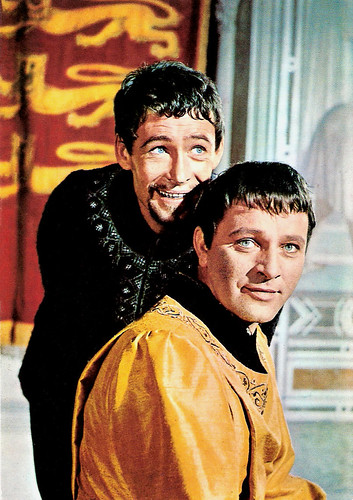
Spanish postcard by Postal Oscarcolor, no. 279. Photo: Publicity shot for Becket (Peter Glenville, 1964) with Peter O'Toole.

Israelian postcard by Editions de Luxe, no. 10.
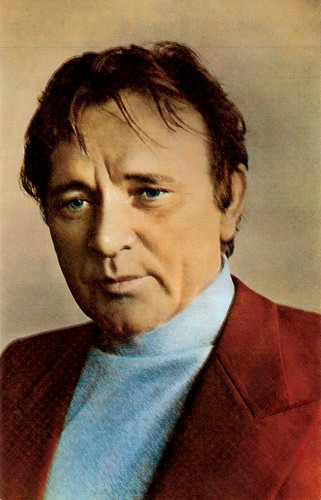
Russian postcard by Izdanije Byuro Propogandy Sovietskogo Kinoiskusstva, 1975. (This postcard was printed in an edition of 200.000 cards.)
Critically reviled films
After twelve years, Richard Burton returned to the stage in 1976 in Equus. He replaced Anthony Perkins as psychiatrist Martin Dysart dealing with a young, sexually troubled patient. He won a special Tony Award for his appearance, although he had to make Exorcist II: The Heretic (John Boorman, 1977) before Hollywood producers would allow him to repeat his role in the film version, Equus (Sidney Lumet, 1977). For this role, he won the Golden Globe Award as well as an Academy Award nomination. Public sentiment towards his perennial frustration at not winning an Oscar made many pundits consider him the favourite to finally win the award, but on Oscar Night he lost to Richard Dreyfuss in The Goodbye Girl.
In 1976 Burton received a Grammy in the category of Best Recording for Children for his narration of The Little Prince by Antoine de Saint-Exupéry. He also found success in 1978, when he narrated Jeff Wayne's Musical Version of The War of the Worlds. His distinctive performance became a necessary part of the concept album – so much so that a hologram of Burton is used to narrate the live stage show (touring in 2006, 2007, 2009 and 2010) of the musical. Burton had an international box office hit with The Wild Geese (Andrew V. McLaglen, 1978), an adventure tale co-starring Roger Moore, Richard Harris and Stewart Granger as mercenaries in Africa. He returned to appearing in critically reviled films like The Medusa Touch (Jack Gold, 1978) opposite Lino Ventura, Circle of Two (Jules Dassin, 1980), and opposite Laurence Olivier as Wagner (Tony Palmer, 1983), a role he said he was born to play, after his success in Equus.
He died shortly after the filming of Michael Radford's adaptation of George Orwell's Nineteen Eighty-Four (1984) was completed. Burton played O'Brien, a sinister member of a totalitarian government who tortured John Hurt's low-ranking office worker for the crime of free thought. He was in terrible health during filming from years of alcoholism and heavy smoking and had to wear a neck brace during rehearsals. His performance as O'Brien in the film was one of his most critically acclaimed performances, as well as one of his most underplayed.
Richard Burton was nominated six times for an Academy Award for Best Actor and once for an Academy Award for Best Supporting Actor – but he never won. Richard Burton was married five times and he had four children. From 1949 until their divorce in 1963, he was married to producer Sybil Williams, by whom he had two daughters, actress Katherine 'Kate' Burton (1957) and Jessica Burton (1961), who was diagnosed as profoundly autistic and would eventually be institutionalised. He was married twice, consecutively, to Elizabeth Taylor, from 1964 to 1974 and from 1975 to 1976. In 1964, the couple adopted a daughter from Germany, Maria Burton (1961). Burton also adopted Taylor's daughter by the late producer Mike Todd, Elizabeth Frances ´Liza´ Todd Burton (1957). In August 1976, a month after his second divorce from Taylor, Burton married model Susan Hunt, the former wife of Formula 1 Champion James Hunt; the marriage ended in divorce in 1982. From 1983 until his death in 1984, Burton was married to make-up artist Sally Hay.
Richard Burton died at age 58 from a brain haemorrhage in 1984 at his home in Céligny, Switzerland, and is buried there. Posthumously the television miniseries Ellis Island (Jerry London, 1984) was shown. It co-starred Richard with his daughter Kate Burton. Brian McFarlane concludes in the Encyclopedia of British Cinema: “In a wayward career, almost as famous for his drinking and his marriages, Burton would intermittently remind audiences of what he could do.”
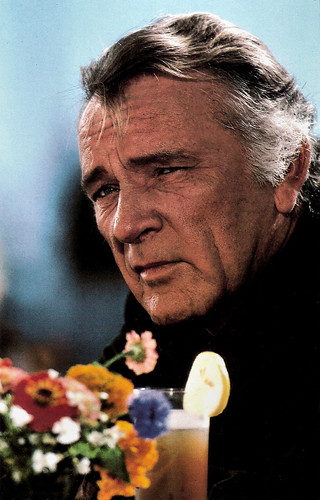
American postcard by Coral-Lee, Rancho Cordova, no. CL/Personality # 71. Photo: Douglas Kirkland, 1981.

German postcard by WS-Druck, Wanne-Eickel, no 226.
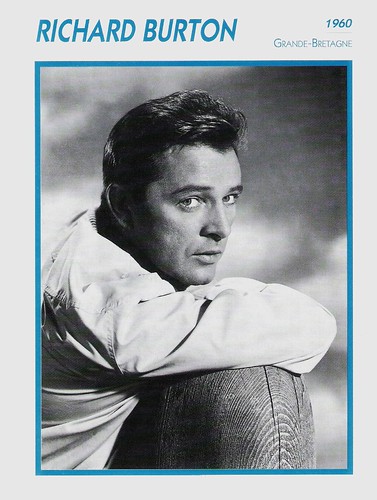
French collectors card in the series 'Portrait de Stars; L'encyclopédie du Cinéma' by Edito Service, 1994. Photo: Kobal Collection. Caption: Great Britain, 1960.

Belgian collectors card in the series 'Filmsterren: een portret' by Edito Service, 1995. Photo: Kobal Collection. Richard Burton in Who's Afraid of Virginia Woolf? (Mike Nichols, 1966). Caption: United States, 1966.
Trailer for Look Back In Anger (1959). Source: ChocolateFrogPrince (YouTube).
Trailer for Cleopatra (1963). Source: DameElizabethTaylor (YouTube).
Sources: Brian McFarlane (Encyclopedia of British Cinema), Hal Erickson (AllMovie), Kit and Morgan Benson (Find A Grave), TCM, Wikipedia and IMDb.
This post was last updated on 23 August 2023.
No comments:
Post a Comment